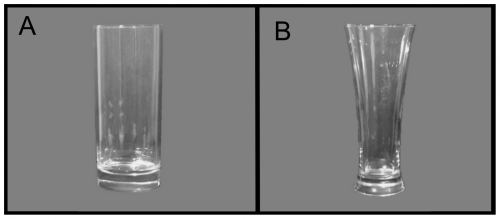Straight-sided (A) and Curved (B) Glasses. Image credit: doi:10.1371/journal.pone.0043007.g001
(Phys.org)—When times get tough, people quite often turn to alcohol to numb themselves to the world around them, and more often than not, their drink of choice is beer, or in Britain, lager. What many who imbibe may not realize though, is that their choice of drinking glass may be impacting the rate at which they consume. A team of researchers from the University of Bristol, thought so, and devised a study to determine if they were right; they enlisted a group of volunteers and as they report in their paper published in PLoS One, found that drinking from a fluted glass caused drinkers to drink faster.
The team notes that they undertook their study because they've grown alarmed, like many in the UK, over the rising levels of binge drinking in that country, which has of course led to societal problems. They note also that such binge drinking appears to be most prevalent in young people who haven't yet learned of the true consequences of doing so or how to meter their drinking as they carry on. Believing that more knowledge is always better, they devised an experiment to find out if the shape of a drinking glass has an impact on how quickly people consume their alcoholic beverage.
The experiment consisted of enlisting the aid of 160 undergraduate volunteers from the university, half male, half female to engage in drinking either lager or non-alcoholic lemonade. Some were given glasses with straight edges, others glasses that were fluted; also some were presented with glasses that were full while others received glasses that were only half so. The volunteers were shown a non-emotional film about animals as they drank and were told beforehand that the experiment was meant to test language.
In observing and timing the rate at which the volunteers consumed their beverages, the team found that those that drank from the full fluted glasses finished in about an average of seven minutes, whereas those drinking from full straight sided glasses did so in about eleven minutes, clearly indicating that glass shape was making an impact on consumption rate. They also noted that those drinking lemonade drank at approximately the same rate as those drinking from the fluted glasses regardless of glass shape. Curiously, they also found that those who received a glass just half full drank at the same pace regardless of glass shape and finished on average in five minutes.
The researchers suggest that the reason people might drink faster from a fluted glass is because they incorrectly gauge consumption rate. Because of the wide top, an illusion is created that makes it difficult to discern pace; what looks like a half full glass for example, is more likely one that is closer to just one quarter full, meaning they've already consumed three quarters of it while thinking they've consumed just half. The end result is faster consumption, which could lead to binge drinking.
More information: Attwood AS, Scott-Samuel NE, Stothart G, Munafò MR (2012) Glass Shape Influences Consumption Rate for Alcoholic Beverages. PLoS ONE 7(8): e43007. doi:10.1371/journal.pone.0043007
Abstract
Background
High levels of alcohol consumption and increases in heavy episodic drinking (binge drinking) are a growing public concern, due to their association with increased risk of personal and societal harm. Alcohol consumption has been shown to be sensitive to factors such as price and availability. The aim of this study was to explore the influence of glass shape on the rate of consumption of alcoholic and non-alcoholic beverages.
Methods
This was an experimental design with beverage (lager, soft drink), glass (straight, curved) and quantity (6 fl oz, 12 fl oz) as between-subjects factors. Social male and female alcohol consumers (n = 159) attended two experimental sessions, and were randomised to drink either lager or a soft drink from either a curved or straight-sided glass, and complete a computerised task identifying perceived midpoint of the two glasses (order counterbalanced). Ethical approval was granted by the Faculty of Science Research Ethics Committee at the University of Bristol. The primary outcome measures were total drinking time of an alcoholic or non-alcoholic beverage, and perceptual judgement of the half-way point of a straight and curved glass.
Results
Participants were 60% slower to consume an alcoholic beverage from a straight glass compared to a curved glass. This effect was only observed for a full glass and not a half-full glass, and was not observed for a non-alcoholic beverage. Participants also misjudged the half-way point of a curved glass to a greater degree than that of a straight glass, and there was a trend towards a positive association between the degree of error and total drinking time.
Conclusions
Glass shape appears to influence the rate of drinking of alcoholic beverages. This may represent a modifiable target for public health interventions.
Journal information: PLoS ONE
© 2012 Phys.org


















